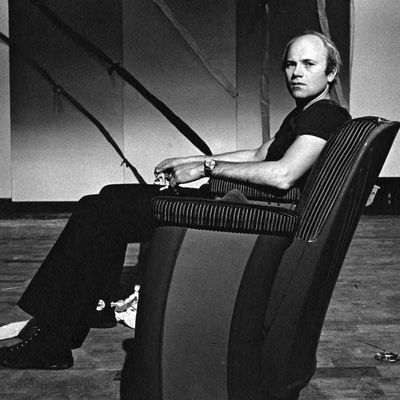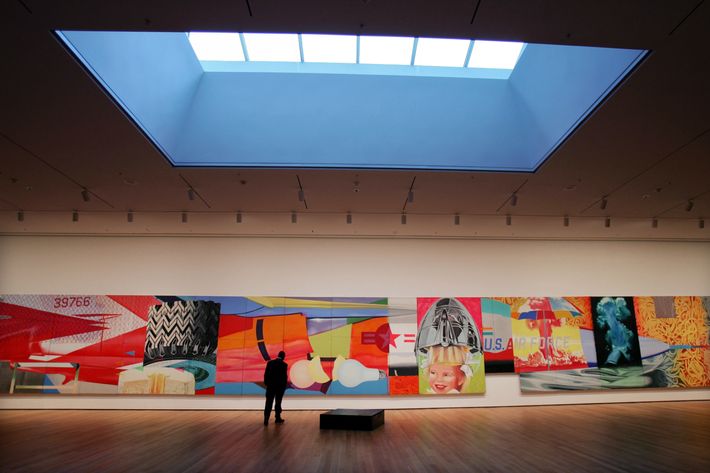
James Rosenquist was a first-generation, first-rank Pop Artist. He got there first and fast. In 1960, Rosenquist, a former sign-painter (as was Warhol and backdrop painter Gerhard Richter), was making neo-Dada semi-abstraction. He got fed up, saying, “Whatever I did, my art wasn’t going to look like everyone else’s.” In a sensational stylistic turnaround, and the equivalent of inventing fire, Rosenquist went from his generic nonrepresentational work to making, in one try, the seven-by-seven foot black-and-white, photographically based realist painting Zone. Even today you can see how it was a new visual-painterly being on earth. A fragmented painted collage of what looks like a woman from advertising and a cut-up grid of some drips or liquid, Zone looks absolutely like advertising, and at the same time, it is not advertising. Thus it is neither a known idea of advertising or of painting. Zone becomes what Donald Judd referred to as a specific object — it is neither one thing or another, but something new. Whatever he did, Rosenquist’s work appeared brand-new back then as it does now. He influenced several generations of artists who looked to popular culture and employed other-than-art techniques.
In this way, Rosenquist emerged instantaneously and fully formed from the culture. Along with other Pop Artists like Warhol and Roy Lichtenstein — and before them Rauschenberg and Johns — Rosenquist blew the doors off art history. All of these artists showed with super-gallerist Leo Castelli — who had only opened five years before. Overnight, advertising and billboard culture barged into American museums and galleries. These artists were the original Mad Men. Everyone took notice. For Rosenquist, Zone began an almost uninterrupted 18-year run of eye-popping vision-machines that dismantled images and ideas of painting. He helped push new American art onto the internationalist popular stage. Rosenquist’s state of painterly grace lasted until the mid-1970s, after which his art settled in, became more predictable, less shocking, impactful, or pictorially inspirational.

Rosenquist took freely from advertising, stock imagery, TV screens, movie posters, anywhere. He painted gloves, chocolate cake, paper clips, Noxzema facial cream, cars, combs, lipstick, hair, guns, Joan Crawford, Marilyn Monroe, and JFK. The early 1960s was a heady revolutionary moment when cultural and political norms were being overturned. Yet, paradoxically, for all this sweeping-away of old ideas and repopulating the stage with new objects, attitudes, methodologies, and ideas, America wasn’t critiquing itself — the way that German artists like Richter and Polke were doing in Germany. America was utterly in love with itself. In 1961, Warhol defined American Pop Art perfectly as “liking things.” Rosenquist’s art reflected this double-edged finger-in-your-face and finger-in-the-pie irony perfectly.
A case in point is his 60-panel, multicolored, walk-in wrap-around 1964-65 masterpiece, F-111. An irregularly shaped ten-foot tall, 86-foot-long rectangle of oil on canvas and aluminum, a shiny gaudy thing — we go from the tail of the supersonic fighter and a proto–Christopher Wool silk-screen pattern of flowery wallpaper serving as the jet exhaust, to a giant tractor tire tread, pound cake, geometric abstract painting here and there, maybe an overhead shot of a cockpit or runway, a woman under a space-helmet-like hair-dryer, the initials USA, a beach umbrella, mushroom cloud, splatters of spaghetti as allusion to Abstract Expressionism and pizza pie, some sea creature or blue cauliflower, weird wallpaper pattern to the aluminum surface and nosecone of the warplane. This is a perfect picture of what America looked, felt, and sounded like in 1965. As perfect as Jackson Pollock summed up 1950 in his epic One: Number 31. (Both works are owned by MoMA.)
Rosenquist’s touch was deadpan, super-skilled, and sassy, simultaneously raising and lowering painterly skill levels in intriguing ways. Chuck Close would pick these ideas up in portraiture by decade’s end. Rosenquist’s work produced a resounding “holy shit!” to artists in the 1960s. Art was moving on. Rosenquist was an important marker in this move. He extended art into the hyperspace of culture and brought more of the culture into art; he took the non sequiturs of everyday life and created what amounted to a buzzing optically alive American Cubism of changing perspectives, optical energy, and aesthetic audacity.

